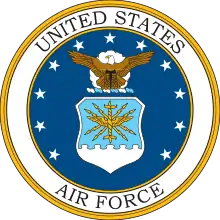New Mexico Wing Civil Air Patrol
The New Mexico Wing Civil Air Patrol (CAP) is the highest echelon of Civil Air Patrol in the state of New Mexico. Its headquarters is located at Kirtland AFB, and the wing is under the command of Colonel Annette R. Peters.
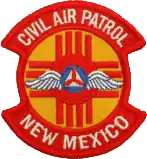 New Mexico Wing of Civil Air Patrol | |
| Associated branches | |
|---|---|
| United States Air Force | |
| Command staff | |
| Commander | |
| Vice Commander | |
| Chief of Staff | |
| Command NCO | |
| Current statistics | |
| Squadrons | 22 |
| Cadets | 371 |
| Seniors | 482 |
| Total Membership | 853 |
| Statistics as of 24 Jun 2019 [1][2] | |
The New Mexico Wing (NMWG) operates in the Southwest Region of the CAP. The Wing consists 4 Groups which command the 22 squadrons. Group 800 is the center to which all school programs report, commanded by Lt Col William Fitzpatrick. CAP squadrons are of three types: Cadet, Composite and Senior.
"Cadet" squadrons consist of basic cadets, with a minimum of three senior members (adults) for supervisory, administrative and training requirements. "Senior" squadrons consist exclusively of senior members, all over the age of 18. "Composite" squadrons consists of both cadets and senior members and conduct both cadet and senior programs.
History
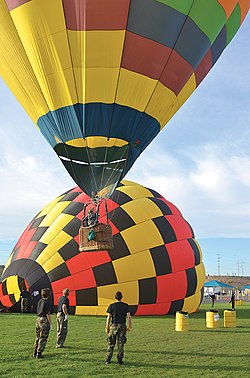
In 1938, plans for a General Aviation Organization was provided to aid the U.S. Military at the home front with the war in Europe building. The idea was approved, thus creating the New Jersey Civil Air Defense Service (NJCADS)
The Civil Air Patrol was created on December 1, 1941 through Administrative Order 9, issued by Fiorello H. LaGuardia in his capacity as Director of the Office of Civilian Defense. Major General John F. Curry was the first National Commander. During World War II, the CAP was seen as a way to use America's civilian aviation resources to aid the war effort instead of grounding them. The organization assumed many missions including anti-submarine patrol and warfare, border patrols and courier services. The CAP pilots sighted 173 enemy U-boats and sank two, dropping a total of 83 bombs and depth charges throughout the entire conflict.[3] From 1946 to 1948, 48 Wings were stood up across the nation, all recruiting civilian volunteers, a large part was 17- to 19-year-old cadets to train and become pilots within the program.
July 1, 1946, Public Law 79-476 enacted CAP to become "Solely of a benevolent character", never again being involved in direct combact activities. May 26, 1948, Congress made CAP the civilian auxiliary of the United States Air Force (USAF) and Congressionally mandated Cadet Program through a curriculum of leadership, aerospace, fitness and character.
The CAP continued to support the U.S. Government directly by enforcing the Peacetime Military Selective Service Act (DRAFT). CAP had a large role in this act by providing Basic Military style training to young cadets, preparing them for the military when they became of age. This was later changed with the removal of the DRAFT in 1973. CAP has since become an organization that does not train cadets for military service, but provide cadets the tools and skills needed to Lead and become outstanding citizens.
In 1956, the USAF recognized the great efforts and military structured program and directed CAP to help develop a USAF Junior ROTC program based on their Cadet Program (CAPC), thus creating the USAF JROTC that we have today. In 1964, CAP modified their Cadet Program to better serve the Cadets and Civil aspects of the program. This modification was not received well throughout the nation, and it became quickly apparent that each CAP unit needed a Professional Teacher or Instructor to incorporate the new program and curriculums to succeed. This was a major change for CAP as it deviated from the original concept of the CAPC program. Unit across the nation pushed back so much so due to the change that between 1969 and 1974, CAP introduced a '5 year moratorium' to incorporate the 'modified' cadet program. During this introduction time frame brought forward revised texts and study materials, and introduced new workbooks, films, training aids, and most important the techniques needed to revise and implement the new program.
1993, a middle school in Houston, Tx modified the Drug Demand Reduction program to incorporate into their school in an attempt to provide a program that would deter students from drugs and other behaviors and incorporate a better learning environment for underprivileged students and make aware the Aerospace Specialty fields available to them. 2006, National Headquarters officially recognized the School Enrichment Program (SEP) as a school affiliated program for grades 6-12. In just 1 year, 70 SEP squadrons were available across 13 states. A pilot program for Junior Cadets was also being fashioned for students in grades K-5. The overall mission of the program was to encourage students and make them aware of the Aerospace careers in the ageing industry and work force as well as promoting community service.
In April 2020, pilots from the New Mexico Wing began flying test kits from the Memorial Medical Center in Las Cruces to Albuquerque for processing as a part of New Mexico's response to the COVID-19 pandemic.[3]
Origins of the New Mexico wing
New Mexico Wing was led by Major Harlee Townsden from December 1, 1941 until June 14, 1943. There is very little documentation about the early history of New Mexico Wing. January 6, 1943, an article released stated, "Two members of the New Mexico Civil Air Patrol have been called into service, Capt. Walter Biddle, in charge of the local CAP squadron, said yesterday. They are Howard Livingston and Henry Mares. Others will be sent into service as fast as they complete their training courses, Capt. Biddle said. Squadrons in Santa Fe, Albuquerque, and Roswell have been ordered into courier duty for the Army according to a dispatch of the Associated Press from Santa Fe." [4]
Civil Air Patrol at Kirtland Field
The Civil Air Patrol operates at and near unit at Kirtland Field. It is a volunteer network of pilots and aviators established during World War II one week before the events at Pearl Harbor. CAP pilots were called the "Flying Minutemen" and specialized in coastal patrols searching for enemy submarines, search and rescue missions throughout the country, and cargo and courier flights to transport materials and personnel.[5]
On June 3, 2011 at Kirtland Air Force Base (AFB), the New Mexico Civil Air Patrol Wing received an "Excellent" rating for its performance on its Air Force mandated Operations Evaluation held on April 29 through May 1 at Kirtland AFB and throughout New Mexico. The evaluation tested the New Mexico CAP's ability to perform Air Force assigned missions, such as homeland security, disaster relief, search and rescue, and counter drug operations. In 2009, the Wing also received an "Excellent" rating when the evaluation's mission base was in Farmington, NM. On that occasion, the Air Force Evaluation Team cited two outstanding performers. They were CAP Lt. Col. Mark Smith (retired colonel), the mission safety officer, and CAP Capt. William Fitzpatrick (Staff Sgt., NM Air National Guard), flight line supervisor.[6]
In 2011, two units were awarded the Civil Air Patrol Quality Cadet Unit Award. Any cadet unit that displays strong program fundamentals can earn the Quality Cadet Unit Award which aims to motivate squadrons to pursue objective goals that are thought will lead to their having a quality Cadet Program. The two squadrons which achieved this were SWR-NM-077 Rio Rancho Falcon Composite Squadron and SWR-NM-083 Albuquerque Heights Composite Squadron.[7]
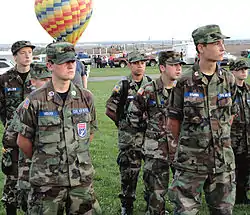
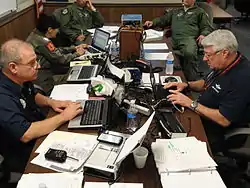
%252C_CAP_Staff_Sgt._Troy_Henson_(center)%252C_and_U.S._Air_Force_Staff_Sgt._Angelito_Cooper_(right).jpg.webp)
New Mexico Wing Commanders
| Name | Date |
|---|---|
| Maj Harlee Townsden | 1 December 1941 - 14 June 1943 |
| Lt Col James L. Breese | 14 June 1943 - 18 January 1946 |
| Lt Col Lewis W. Brahn | 18 January 1946 - 18 March 1947 |
| Lt Col Horner D. Bray | 18 March 1947 - 15 September 1947 |
| Lt Col Earl W. Stark | 15 September 1947 - 23 March 1948 |
| Col Kilbourne L. House | 23 March 1948 - 20 January 1950 |
| Lt Col Howard E. Livingston | 20 January 1950 - 25 July 1950 |
| Lt Col Herbert V. Scanlan | 25 July 1950 - 20 February 1951 |
| Col Harlold E. Sanford | 20 February 1951 - 22 March 1951 |
| Col W. Randolph Lovelace, VII | 22 March 1950 - 3 April 1950 |
| Col Harold E. Sanford | 3 April 1951 - 13 June 1951 |
| Col J. Gibbs Spring | 13 June 1951 - 30 November 1960 |
| Col Homer L. Bigelow, Jr | 30 November 1960 - 28 January 1963 |
| Col Harold D. Thomas | 28 January 1963 - 4 October 1965 |
| Lt Col Harry H. Crosby, Jr | 4 October 1965 - 3 December 1965 |
| Col Richard T. Dillon | 3 December 1965 - 10 February 1969 |
| Col W. Dale Parson | 10 February 1969 - 18 March 1972 |
| Col Richard A. Damerow | 18 March 1972 - 6 March 1975 |
| Col Earl F. Livingston | 6 October 1975 - 27 October 1979 |
| Col Lloyd A. Sallee | 27 October 1979 - 20 November 1982 |
| Col William C. Overton, Jr | 20 November 1982 - 26 October 1985 |
| Col Larry A. Harrah | 26 October 1985 - 4 January 1988 |
| Col Robert G. Haulenbeek, Jr | 4 January 1988 - 13 April 1991 |
| Col Donald Jakusz | 13 April 1991 - 24 April 1993 |
| Col Joseph Gold | 24 April 1993 - 19 August 1995 |
| Col Dennis Manzanares | 19 August 1995 - 14 August 1999 |
| Col James Norvell | 14 August 1999 - 20 September 2003 |
| Col Frank Buethe | 20 September 2003 - 19 May 2007 |
| Col Richard F. Himebrook | 20 June 2007 - 25 June 2011 |
| Col Mark E Smith | 25 June 2011 - 27 June 2015 |
| Col Mike Lee | 27 June 2015 – 23 June 2019 |
| Col Annette R. Peters | 23 June 2019 – Present |
Structure
The New Mexico Wing is the highest echelon of the Civil Air Patrol in New Mexico. It reports to the South West Region CAP, which reports to CAP National Headquarters. The wing supervises the individual groups and squadrons that comprise the basic operational unit of the CAP. The New Mexico Wing headquarters are located at Kirtland AFB, New Mexico. New Mexico Civil Air Patrol is also governed under Ch. 20, art. 7 NMSA 1978 under the New Mexico Department of Military Affairs, Commanded by the Adjutant General of the State. [8]
Below the Wing level, New Mexico is divided into Groups with subordinate squadrons. Groups report directly to the wing level and squadrons report directly to their Group HQ. Squadrons are the local level of organization, and they meet weekly to conduct training and education to continue to accomplish the Congressionally mandated Cadet Program through a curriculum of leadership, aerospace, fitness and character. Following a military model, the program emphasizes the Air Force traditions and values; Shaping Today's Cadets into Tomorrow's Aerospace Leaders.
There are three types of Civil Air Patrol squadrons:
- A cadet squadron focus primarily on training, leadership development and activities for CAP cadets.
- A senior squadron is a unit dedicated to allowing senior members to focus on CAP's missions, normally search and rescue activities.
- Composite squadrons offer programs for both cadets and senior members.
Northern Group
Commander ![]() Lt Col Andrew Selph
Lt Col Andrew Selph
| Sqd. No | Name/Type | Location |
|---|---|---|
| SWR-NM 018 | Santa Fe Composite Sq | Santa Fe |
| SWR-NM 068 | Farmington Composite Sq | Farmington |
| SWR-NM 085 | Route 66 Composite Sq | Edgewood |
| SWR-NM 016 | Los Alamos Composite Sq | Los Alamos |
| SWR-NM 006 | Taos Composite Sq | Taos |
Central Group
Commander ![]() Lt Col Michael Eckert
Lt Col Michael Eckert
| Sqd. No | Name/Type | Location |
|---|---|---|
| SWR-NM 083 | Albuquerque Heights Composite Sq | Albuquerque |
| SWR-NM 030 | Albuquerque Senior Sq II | Kirtland AFB |
| SWR-NM 012 | Eagle Cadet Sq | Kirtland AFB |
| SWR-NM 055 | West Mesa Composite Sq | Albuquerque |
| SWR-NM 077 | Rio Rancho Falcon Composite Sq | Rio Rancho |
| SWR-NM 033 | Thunderbird Composite Sq | Kirtland AFB |
Southern Group
Commander ![]() Lt Col Dennis Hunter
Lt Col Dennis Hunter
| Sqd. No | Name/Type | Location |
|---|---|---|
| SWR-NM 073 | Alamogordo Composite Sq | Alamogordo |
| SWR-NM 060 | Clovis High Plains Composite Sq | Clovis |
| SWR-NM 024 | Las Cruces Composite Sq | Las Cruces |
| SWR-NM 082 | Roswell Composite Sq | Roswell |
| SWR-NM 084 | Socorro Composite Sq | Socorro |


Group 800
Commander ![]() Lt Col William R. Fitzpatrick
Lt Col William R. Fitzpatrick

| Sqd. No. | Sqd. Name/Type | Location |
|---|---|---|
| SWR-NM 811 | LBJ MS Cadet Sq | Albuquerque |
| SWR-NM 816 | AIMS Cadet Sq | Albuquerque |
| SWR-NM 818 | Tony Hillerman MS Cadet Sq | Albuquerque |
| SWR-NM 819 | Belen MS Cadet Sq | Belen |
| SWR-NM 822 | Socorro HS Cadet Sq | Socorro |
| SWR-NM 823 | Clovis Schools Cadet Sq | Clovis |
Legislative
| Sqd. No | Name/Type | Location |
|---|---|---|
| SWR-NM-999 | Legislative Squadron | N/A |
Legal protection
Members of the Civil Air Patrol who are employed within the state of New Mexico are entitled to up to fifteen days of leave annually from their place of employment to take part in search and rescue missions conducted by the Civil Air Patrol.[10]
References
- http://www.capnhq.gov
- "eServices, National Headquarters". Civil Air Patrol., login required
- "Civil Air Patrol helps transport coronavirus test kits". KRQE. April 29, 2020. Retrieved May 3, 2020.
- Ted Spitzmiller and Gwen Sawyer, Enchanted Wing: the History of the New Mexico Wing Civil Air Patrol (publication place: iUniverse, 2009), 5-6. "ISBN 9781440181269"
- "Archived copy" (PDF). Archived from the original (PDF) on May 3, 2012. Retrieved June 16, 2013.CS1 maint: archived copy as title (link)
- Civil Air Patrol receives ‘Excellent’ rating on performance evaluation.
- http://www.capmembers.com/media/cms/QUA_2011_F7965D44C98A9.pdf
- "NM Stat § 20-7 (2016)". Justia. 2016. Retrieved June 24, 2019.
- Units. Nmcap.us.
- "NM Stat § 20-7-5 (2016)". Justia. 2016. Retrieved October 20, 2017.
